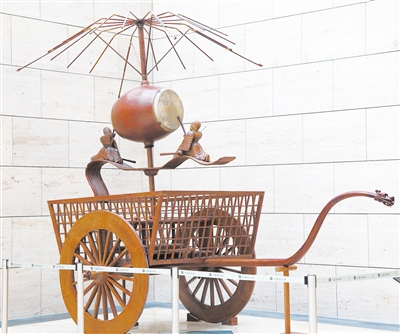
 |
| The mileage drum wagon at the Six Dynasties Museum in Nanjing city, Jiangsu province. (PHOTO: VCG) |
In modern society, every car is equipped with an automatic odometer to record the distance traveled. However, in China, as early as in the Han Dynasty(206 BC-220 AD), a device known as the mileage drum wagon was invented. It can be said that the mileage drum wagon is a pioneer of modern odometers.
Its basic principle is to calculate mileage by means of differential gears. The wagon has a set of differently-sized gears connected to the axle. When the wheel rotates, it makes the gears rotate as well.
The mileage drum wagon gets its name from the mechanical-driven wooden figure on the wagon carrying a drum and a bell and connected to the gears.
When the wagon travels one li (or 500 meters), the gear controlling the figure rotates once, causing it to hit the drum once with its mechanical-operated arm. When the wagon travels ten lis, the figure rings the bell. A person sitting in the carriage can tell how far the carriage has traveled just by hearing the sound.
In addition to calculating mileage, the mileage drum wagon was also a ceremonial vehicle for Chinese emperors to travel. Therefore it was large and luxuriously decorated to show the emperor's supreme status.
The mileage drum wagon embodies the wisdom of ancient Chinese people. However, it didn't automatically record mileage, and the passengers had to count the number of drum beats to gauge the distance covered. But after more than 2,000 years of the development of science and technology, modern odometers have addressed that by recording the mileage electronically.







